If you love to learn about the universe, you’ll love learning about different types of galaxies. There are many different types of galaxies in the Universe, and each one is fascinating in its own way. In this blog post, we’ll discuss some of the most common types of galaxies. Stay tuned for More!
There are mainly 3 different types of galaxies in the Universe: spiral, elliptical, and irregular. Each type of galaxy has its distinct appearance, but all are fascinating examples of the sheer variety found in the Universe.
Spiral galaxies, like our own Milky Way, have arms that wind around a central bulge of stars. Elliptical galaxies are elongated and lack the spiral structure of spiral galaxies. Finally, irregular galaxies do not fit neatly into any one category; they may have no defined structure or maybe in the process of merging with another galaxy.
Galaxies come in all shapes and sizes, but galaxies with unusual traits stand out. For example, there is the prospect of colliding or interacting ones; some even have active nuclei that shoot jets into space!
There are also highly charged regions within galaxies where lots going on at once: active nuclei ejecting jets; merging overdensities caused by proximity assisting one another through gravity ties–all happening while.
⫸ Key Facts & Summary of different types of galaxies:
- Galaxies come in a variety of shapes and sizes, from elliptical to spiral.
- They can be further categorized by their shape.
- Elliptical galaxies are usually comprised of very old stars or low-mass counterparts. They make up around 10% of the Virgo Supercluster, a nearby group consisting mainly (80%) spiral-shaped objects with bright cores and Vacca Surprise Coordinates near its center!
- These ellipticals can be seen as dimmer versions compared to their faster-moving cousins; this one has been spotted just 500 million years away from us here on Earth – that’s practically next door!
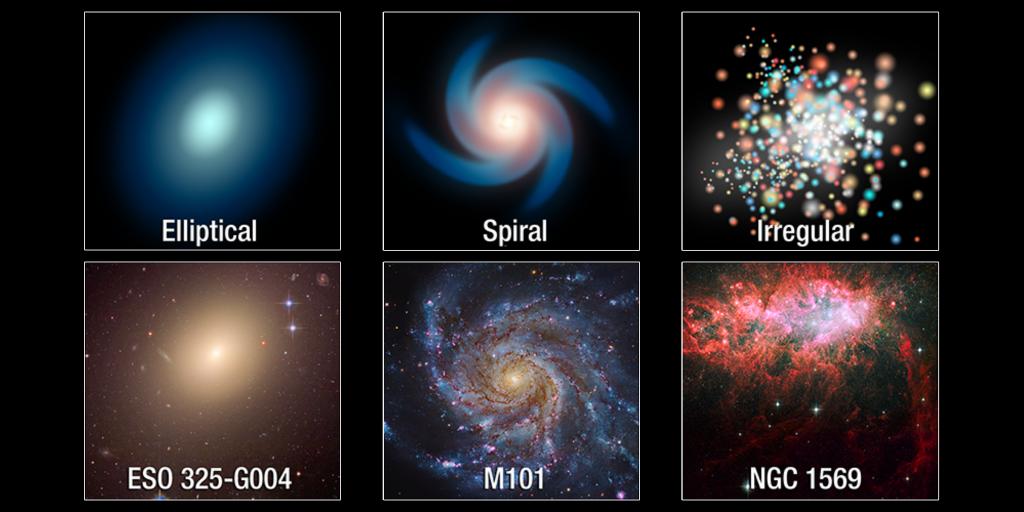
- Barred spiral looks like short trains with arms that fork off into two directions – these types tend not to work well when it comes down to size since they’re very compact compared to other kinds such as the irregular galaxy which has no pattern whatsoever!
- Irregular galaxies can be found throughout the universe and they make up about a quarter of all that is known. These bizarrely shaped collections lack organization, often having an appearance like chaos itself!
- The vast majority of galaxies in our universe are spirals.
- They make up 77%! One example that comes to mind is the Andromeda Galaxy, which you can see curving across the sky on clear nights with an excellent pair of binoculars or a small telescope.
- The most common type found throughout space may be spiral galaxy and it lies within this region known as Local Group Migraineurs Telescopes observatories.
- However there’s no need for any special equipment here because we’re looking at just one particular formation – The nearest large-scale structure nearby enough to offer us clues about how these things formed.
- The average galaxy is about 100.000 light-years in diameter, but some galaxies can be as small or large as 1 million parsecs!
Read: ✅ Discovery of Exoplanets in 2021
◉ Spiral galaxies:
Spirals are characterized by circular symmetry, a dazzling core surrounded by a small outer disc, and an overlaying spiral structure. There are two sorts of spirals: normal spirals and barred spirals.
Barred spirals contain a brilliant linear structure termed a bar that straddles the nucleus, with the arms unwinding from the ends of the bar, whereas conventional spirals have arms that emanate from the nucleus.

A spiral galaxy’s nucleus is a sharp-peaked area of smooth texture that can be fairly small or can make up the majority of the galaxy. The arms and disc of a spiral system are both blue, whereas the center portions of an elliptical galaxy are red.
S stands for standard spirals, and SB stands for barred spirals. According to the size of the nucleus and the degree to which the spiral arms are coiled, each of these classes is subdivided into three types.
The lowercase letters a, b, and c represent the three categories. There are also transitional galaxies between ellipticals and spirals. The disc shape of such systems is similar to that of the latter, but there are no spiral arms. S0 is the designation for these intermediate types.
◉ Elliptical galaxies:
These systems have certain distinguishing characteristics. They have perfect rotational symmetry, which means they have two equal primary axes. They have a third, smaller axis that is thought to be the rotating axis. At optical wavelengths, the surface brightness of ellipticals diminishes monotonically outward from a maximum value in the center,
following a standard mathematical law of the form: I = I0( r/a +1 )−2,
where “I” denotes the light intensity, “I0″ denotes the center intensity, “r” denotes the radius, and “a” denotes the scaling factor.
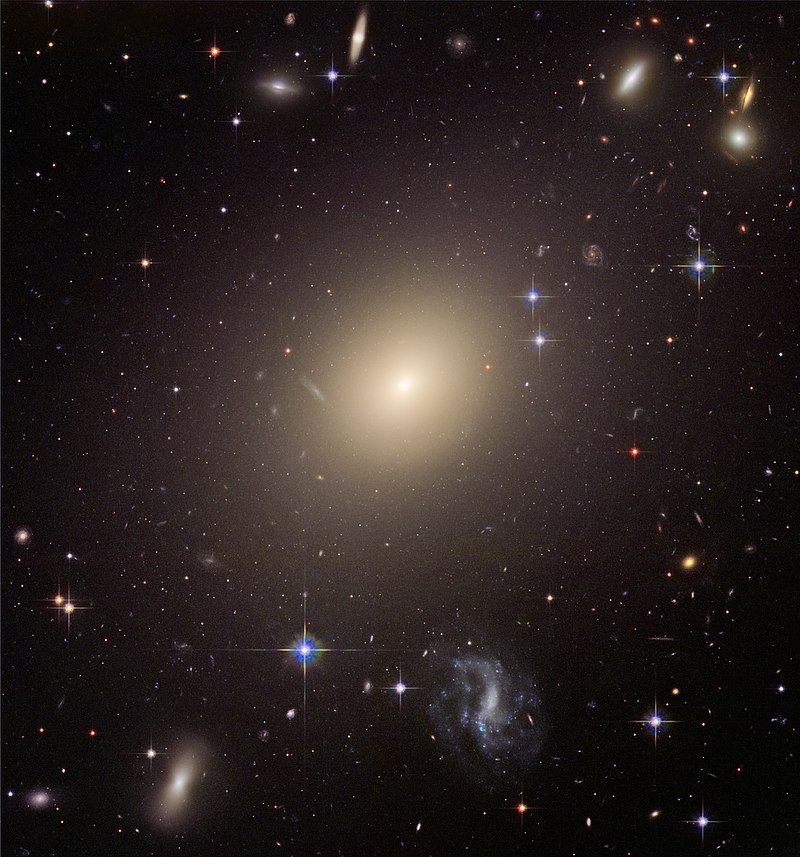
An elliptical system’s isophotal contours are comparable ellipses with a shared orientation, each centered on its nucleus. No galaxy of this sort is flatter than b/a = 0.3, where b and an are the elliptical image’s minor and major axes, respectively. Interstellar dust and brilliant stars of the spectral categories O and B are not found in ellipticals.
Many, on the other hand, have indications of low-density gas in their nuclear regions. Ellipticals have a red color, and their spectra show that their light derives primarily from old stars, particularly developed red giants.
The apparent shape of elliptical galaxies, which is not necessarily their three-dimensional shape, is used to classify them into subclasses. En is the designation, with n being an integer defined by n = 10( a− b)/a.
An E0 galaxy is a perfectly round image, but an E7 galaxy is a flatter object. (Elliptical galaxies are never flattered than this, as mentioned above, hence there are no E8, E9, or E10 galaxies.)
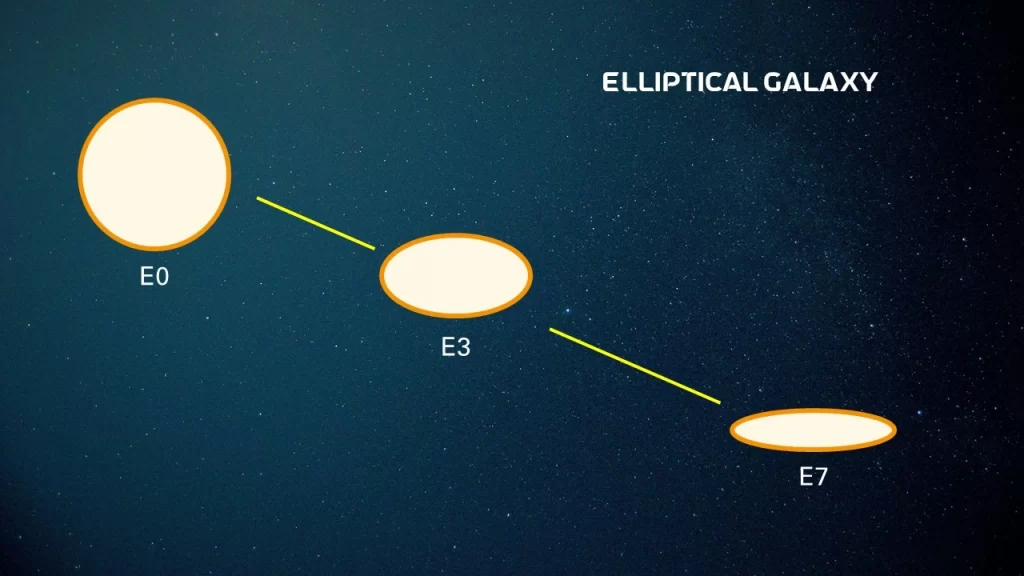
Even though the aforementioned criteria are widely accepted, recent high-quality measurements have revealed that there are some considerable discrepancies. Most elliptical galaxies, for example, do not completely meet Hubble’s intensity rule; aberrations can be seen in the galaxy’s innermost and faintest sections.
In addition, the ellipticity of many elliptical galaxies varies slowly, with the pictures being more circular in the inner regions than in the outer areas. The principal axes do not always line up, and their position angles in the outer sections vary.
Finally, astronomers discovered that a few ellipticals do feature dust lanes as well as a tiny number of bright O and B stars.
◉ Irregular galaxies:
The majority of members of this group are made up of grainy, very irregular assemblages of light regions. They lack symmetry and a central center, and their arms and discs are often bluer in color than spiral galaxies’ arms and discs. However, only a small percentage of them are red and have a smooth, if asymmetrical, shape.
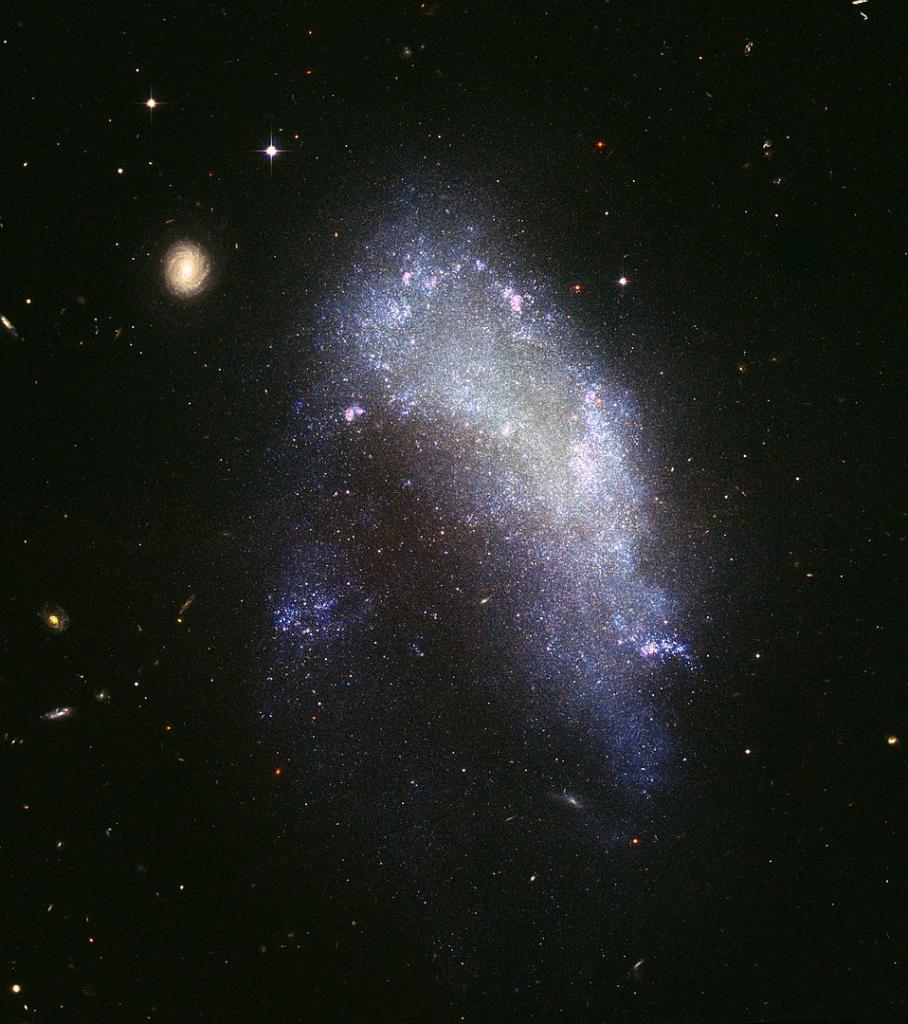
Irr I and Irr II are two types of irregular galaxies identified by Hubble. The Irr I type is the most frequent of the irregular systems, and it appears to be the result of a natural extension of the spiral classes beyond Sc, into galaxies with no obvious spiral structure.
They’re blue, highly resolved, and lack a nucleus. The Irr II systems are rare and red. They encompass numerous types of chaotic galaxies for which there appear to be many potential causes, including the most typical outcomes of galaxy-galaxy interactions, as well as tidal distortions and cannibalism; as a result, this group is no longer recognized as a valid approach to classify galaxies.
◉ S0 galaxies:
These systems have characteristics of both ellipticals and spirals and appear to be a link between the two more prevalent galaxy types. Hubble established the S0 class long after his initial categorization approach had become widely accepted, owing to a scarcity of severely flattened objects with otherwise elliptical galaxies-like features. The qualities given here are the result of Sandage’s elaboration of the S0 class.
A luminous core is surrounded by a smooth, featureless bulge and a dim outer envelope in S0 galaxies. They are thin; statistical examinations of the apparent axes ratio (as projected onto the sky) show that their intrinsic minor to major axes ratios are in the range of 0.1 to 0.3.
Their structure is more like that of spiral galaxies and does not generally follow the luminosity law of elliptical galaxies. Some S0 systems feature weakly discernible armlike discontinuities or narrow absorption lanes caused by interstellar dust in their envelopes. Several S0 galaxies are unusual in other ways, making it impossible to categorize them with precision.
They can be thought of as strange irregular galaxies (Irr II galaxies) or simply as some of the 1% to 2% of galaxies that do not easily fit into the Hubble scheme. Galaxies like NGC 4753, which has uneven dust lanes across its picture, and NGC 128, which has a double, almost rectangular bulge surrounding a central center, are examples of them. NGC 2685 contains a different sort of unusual S0.
◉ Sa galaxies:
The presence of interstellar dust and, in many cases, brilliant stars makes these regular spirals appear to have narrow, tightly wound arms. The majority of them have a big amorphous bulge in the center, but others defy this by having a small nucleus surrounded by an amorphous disc with superimposed faint arms. NGC 1302 is a typical Sa galaxy, but NGC 4866 is an example of one with a tiny nucleus and arms made up of thin dust lanes on a smooth disc.
◉ Sb galaxies:
The nucleus of this intermediate spiral is usually medium in size. Stars, star clouds, interstellar gas, and dust are all found there. In terms of shape, Sb galaxies display a wide range of dispersion.
For example, Hubble and Sandage discovered that in some Sb galaxies, the arms appear at the nucleus, which is often rather tiny. Others have arms that start tangent to a bright, virtually circular ring, while others have a small, bright spiral pattern inserted into the nuclear bulge. The spiral arms can be configured at varied pitch angles in any of these scenarios.
Hubble and Sandage discovered other departures from the Sb galaxies’ typical form. A chaotic dust pattern is superimposed on the tightly bound spiral arms in a few systems.
Some feature smooth, thick arms with a low surface brightness that are commonly delimited by dust lanes on their inner margins. Finally, some people have a huge, smooth nuclear bulge from which the arms radiate forth tangent to the bulge, generating short arm segments. This is the most well-known type of Sb galaxy, which is best represented by the massive Andromeda Galaxy.
Many of these form variances are yet unexplained. Although theoretical models of spiral galaxies based on a variety of assumptions can mimic the basic Sb galaxy shape, many of the above-mentioned variations have a mystery explanation and will require more extensive and realistic galactic dynamics modeling.
◉ Sc galaxies:
These galaxies’ nuclei are frequently small, with many spiral arms that are open and have wide pitch angles. Furthermore, the arms are lumpy, including a large number of irregularly scattered star clouds, stellar associations, star clusters, and emission nebulae.
Sc galaxies, like Sb galaxies, are divided into various kinds. Six subdivisions were mentioned by Sandage:
- Galaxies with thin branched arms that run outward from a tiny center, usually stretching outward for around 180 degrees before branching into many segments, such as the Whirlpool Galaxy (M51);
2. systems with multiple arms that start tangent to a bright ring centered on the nucleus,
3. systems with arms that are poorly defined and span the entire image of the galaxy,
4. systems with a spiral pattern that can’t be easily traced and is multiple and punctuated with chaotic dust lanes,
5. systems with thick, loose arms that aren’t well defined—e.g., the nearby galaxy M33 (the Triangulum Nebula)
6. transition kinds, which are nearly devoid of the organization to the point that they could be classified as irregular galaxies.
Some classification methods, such as that of Gerard de Vaucouleurs, a French-born American astronomer, assign type Sd to the last of the aforementioned subtypes. Some of the fluctuations observed here for Sc galaxies have also been linked to overall luminosity.
Galaxies of the fifth subtype, in particular, are fundamentally dim, but those of the first subtype are among the brightest spirals ever discovered. This relationship is explained below as part of the reason for the luminosity categorization.
◉ SB galaxies:
The barred spirals’ luminosities, diameters, spectra, and distributions are often indistinguishable from those of conventional spirals. SB systems have subclasses that run concurrently with those of the latter.
SB0 galaxies have a huge nuclear bulge surrounded by a disklike envelope with a luminous featureless bar running across it. Short bars appear on certain SB0 systems, but bars that span the full-viewable image appear on others.
A ring-like structure can be found on the outside of the bar on occasion. SBa galaxies have brilliant, relatively big nuclear bulges as well as tightly wrapped, smooth spiral arms that arise from the bar’s ends or a circular ring outside the bar.
SBb systems have a smooth bar and arms that are relatively smooth and consistent. The arms begin at or near the ends of the bar in certain galaxies of this kind, with prominent dust lanes running down the inner of the bar to the nucleus.
Others feature arms that begin at a tangent to a ring on the bar’s outside. Both the arms and the bar in SBc galaxies are strongly resolved into stellar associations and star clouds. The arms are open in shape and can begin at either the bar’s ends or tangent to a ring.
⫸ Conclusion:
So, what’s your favorite galaxy? Are you a spiral kind of person or do you prefer an elliptical galaxy? We can’t wait to see what you think about the different types of galaxies in the universe. Share with us in the comments below. And if you’re interested in learning more about galaxies, be sure to check out our other posts on the subject. Until next time!

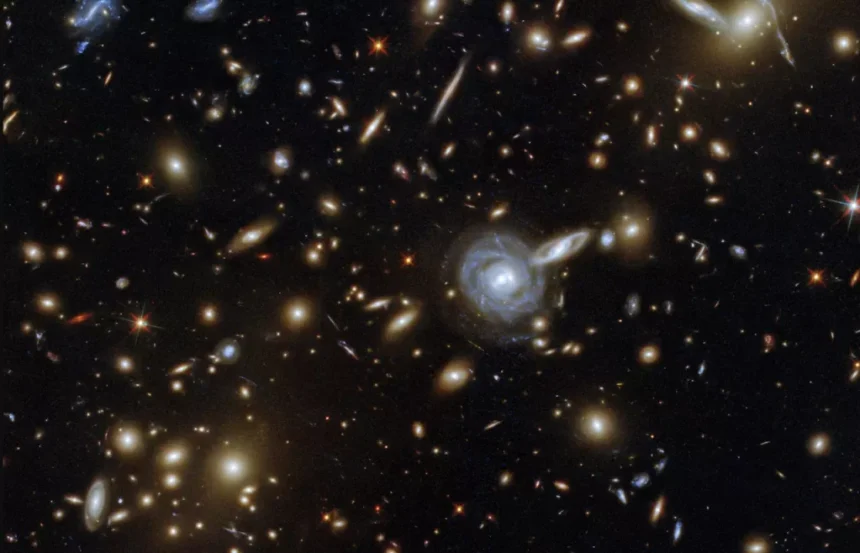
certainly like your website but you need to take a look at the spelling on quite a few of your posts Many of them are rife with spelling problems and I find it very troublesome to inform the reality nevertheless I will definitely come back again